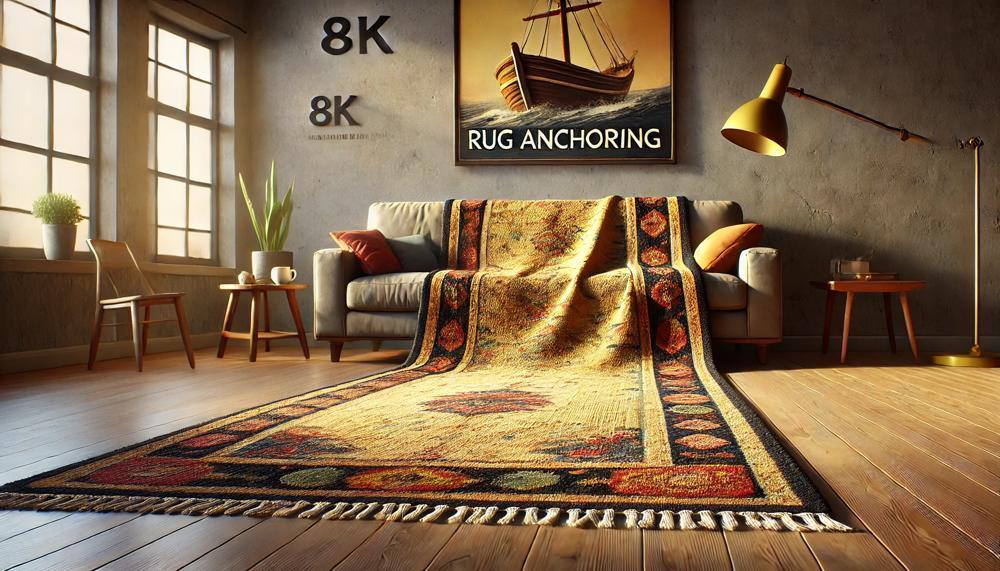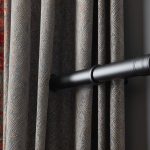Struggling to keep your rug in place on a carpet? You’re not alone. Many people face the challenge of a creeping rug, but anchoring it can be simple and effective with the right approach. One of the best solutions is using anti-slip mats.
These mats provide exceptional grip, preventing any unwanted movement and ensuring your rug stays put.
In this guide, we’ll walk you through various methods to anchor a rug on a carpet, focusing on the use of anti-slip mats and other handy tips.
Here’s what you’ll learn:
- Why Anti-Slip Mats are Essential: Discover how these mats offer superior grip and stability.
- Alternative Methods: Explore using heavy furniture or sticky tape to secure your rug.
- Answers to Common Questions: Get insights into keeping rugs stationary and whether it’s okay to place them on carpets.
Proper anchoring not only keeps your space looking neat but also prevents accidents caused by slipping rugs. Read on to find out how to keep your rug firmly in place and enjoy a safer, more attractive home.
Contents
Why Use Rugs with Carpet?
Using rugs with carpet offers a multitude of benefits and can significantly enhance the overall look and feel of a room. Here are the key advantages and how they can transform your space:
| Benefit | Description | Additional Tips |
| Style and Texture | Enhances visual interest with added layers and patterns. | Choose bold patterns for a striking effect. |
| Cost-Effective Update | Refreshes room decor without extensive renovations. | Select rugs that complement your existing decor. |
| Cozy Ambiance | Adds warmth and comfort to the space. | Opt for thick, plush rugs for extra coziness. |
| Defining Spaces | Helps to organize and define different areas in open-plan layouts. | Use contrasting rugs to clearly delineate spaces. |
| Protecting Carpet | Reduces wear and tear in high-traffic areas. | Place rugs in entryways and hallways for added protection. |
| Enhancing Colour Scheme | Introduces new colours and ties the room together. | Match rug colours with accent pieces in the room. |
| Reducing Noise | Absorbs sound and reduces noise levels. | Layer rugs in rooms with hard flooring for maximum effect. |
Get Textured
To anchor a rug on carpet effectively by adding texture, consider these methods:
- Anti-Slip Mats: Place an anti-slip mat under the rug. These mats, often made from materials like rubber or PVC, create a textured surface that grips both the rug and the carpet, preventing slippage. Their raised patterns enhance friction, making the rug stay put.
- Rug Pads with Texture: Invest in a textured rug pad. These pads have a slightly rough surface and are designed to add a layer of grip between the rug and the carpet. This added texture not only keeps the rug from shifting but also provides a cushioning effect, enhancing comfort.
- Textured Backing: Opt for rugs with textured backing. Some rugs come with a special backing that is textured or rubberized. This backing clings to the carpet fibers, helping to keep the rug in place without additional accessories.
- Rug Grippers: Use rug grippers or corner grippers. These are adhesive or rubber-based tabs placed at the corners or edges of the rug. They add texture at critical points to prevent the rug from curling or moving.
- Adding Heavy Furniture: Strategically place heavy furniture on parts of the rug. This method uses the weight of the furniture to press down on the rug, increasing its stability and anchoring it to the carpet below.
- Textured Tape: Utilize textured double-sided carpet tape. This tape sticks to both the rug and the carpet, providing a textured grip that holds the rug in place. It’s a simple and cost-effective solution for anchoring rugs.
Prevent Wrinkles
To prevent wrinkles in a rug placed on top of carpet, the best methods are:
| Method | Description | Effectiveness |
| Re-Stretch the Carpet | Pulls carpet outward to eliminate wrinkles | High |
| Rug Grippers or Anti-Slip Mats | Provides stability and prevents movement | High |
| Heavy Furniture Placement | Anchors the rug down with weight | Moderate |
| Double-Sided Carpet Tape | Secures rug to carpet to prevent shifts | Moderate |
| Rug Pad with Cling Effect | Holds rug in place on carpet | Moderate |
Avoid popular fixes like steaming, ironing, and applying ice, as they can damage both the rug and the carpet.
Size Does Matter
The size of a rug is vital when anchoring it on carpet because it influences stability, aesthetics, and functionality. A properly sized rug ensures that it stays in place, reducing the risk of trips and slips.
Moreover, it enhances the visual appeal and cohesion of the room by appropriately defining spaces.
Stability and Safety
A rug that is too small can easily shift, causing tripping hazards. When a rug covers a larger area, it has more contact with the carpet underneath, providing better grip and less movement.
This is especially important in high-traffic areas where frequent movement can cause smaller rugs to bunch up or slide.
Aesthetics and Room Definition
The rug size affects the room’s visual harmony. A correctly sized rug can tie a room together by anchoring furniture and defining areas. For instance, a rug that fits under all major pieces of furniture, like a living room sofa set, creates a unified look.
Conversely, a small rug might look out of place, disrupting the room’s flow and making the space seem disjointed.
| Rug Size | Impact on Stability | Impact on Aesthetics |
| Large | High stability, less movement, reduced tripping hazards. | Creates a cohesive look, anchors furniture, and defines spaces. |
| Medium | Moderate stability, may require additional anchoring like rug pads. | Can be visually appealing if properly placed under key furniture pieces. |
| Small | Low stability, prone to shifting and bunching. | Can look out of place, may not effectively define spaces. |
Practical Tips for Choosing the Right Size
- Measure Your Space: Ensure the rug is large enough to fit under major furniture. For example, in a living room, all front legs of the furniture should be on the rug.
- Use Anchors: Combine the right size with anchoring methods like rug pads or tape to enhance stability.
- Aesthetic Considerations: Choose a rug that complements the room’s décor and doesn’t overwhelm or underwhelm the space.
By carefully selecting the right rug size, you enhance both the safety and style of your home.
Color Choice
Different color choices for rugs and carpets significantly influence the overall aesthetic of a room by altering its mood, visual impact, and harmony with existing decor. Here’s a breakdown of how various colors can affect the ambiance:
| Color | Effect on Room | Best Used In |
| Neutral Colors (Beige, Gray, White) | These hues create a calm, spacious feeling and blend seamlessly with most decor styles, providing a clean and modern look. | Living rooms, Bedrooms, Offices |
| Warm Colors (Red, Orange, Yellow) | Warm tones evoke a sense of coziness and energy, making spaces feel more inviting and lively. They can make large rooms feel more intimate. | Living rooms, Dining areas, Playrooms |
| Cool Colors (Blue, Green, Purple) | Cool colors are soothing and can make a room feel tranquil and expansive. They are perfect for creating a serene and refreshing environment. | Bedrooms, Bathrooms, Reading nooks |
| Dark Colors (Navy, Charcoal, Deep Green) | Dark rugs add drama and sophistication to a room, creating a bold statement. They are great for hiding stains and adding warmth to spacious areas. | Large living areas, Offices, Formal rooms |
| Light Colors (Pastels, Light Gray, White) | Light-colored rugs can make small spaces feel larger and more open. They also contribute to a clean, airy look but may require more maintenance. | Small rooms, Entryways, Kids’ rooms |
| Patterned Rugs | Patterns can introduce texture and interest, hiding stains and dirt well. They can tie together various elements in a room, adding a dynamic touch. | Living rooms, High-traffic areas, Eclectic spaces |
Tips for Choosing Rug Colors

- Complement vs. Contrast: Decide if you want the rug to complement the existing color scheme or act as a contrasting focal point.
- Room Function: Consider the purpose of the room. For example, calming colors are ideal for bedrooms, while vibrant colors work well in social spaces.
- Lighting: Check how the rug color looks under different lighting conditions to ensure it maintains the desired effect throughout the day.
- Size and Space: Use darker colors in larger rooms to add coziness and lighter colors in smaller rooms to create an illusion of space.
Conclusion
In conclusion, effectively anchoring a rug on a carpet can be simple with the right tools and techniques. Using anti-slip mats is the most recommended method as they offer superior grip and stability, ensuring your rug stays in place. These mats, typically made from rubber or PVC, provide a textured surface that grips both the rug and the carpet, preventing any unwanted movement.
For those seeking alternative methods, heavy furniture can serve as an effective anchor by placing it on the edges of the rug. Additionally, sticky double-sided carpet tape can be used to secure the rug firmly to the carpet. Another option is to invest in textured rug pads or rugs with a textured backing, both designed to enhance grip and prevent slippage.
These anchoring solutions not only maintain a neat and tidy appearance but also prevent accidents caused by slipping rugs. Properly anchored rugs can also add style, texture, and a cozy ambiance to a room, protect the underlying carpet, define spaces in open-plan areas, enhance the color scheme, and reduce noise.





